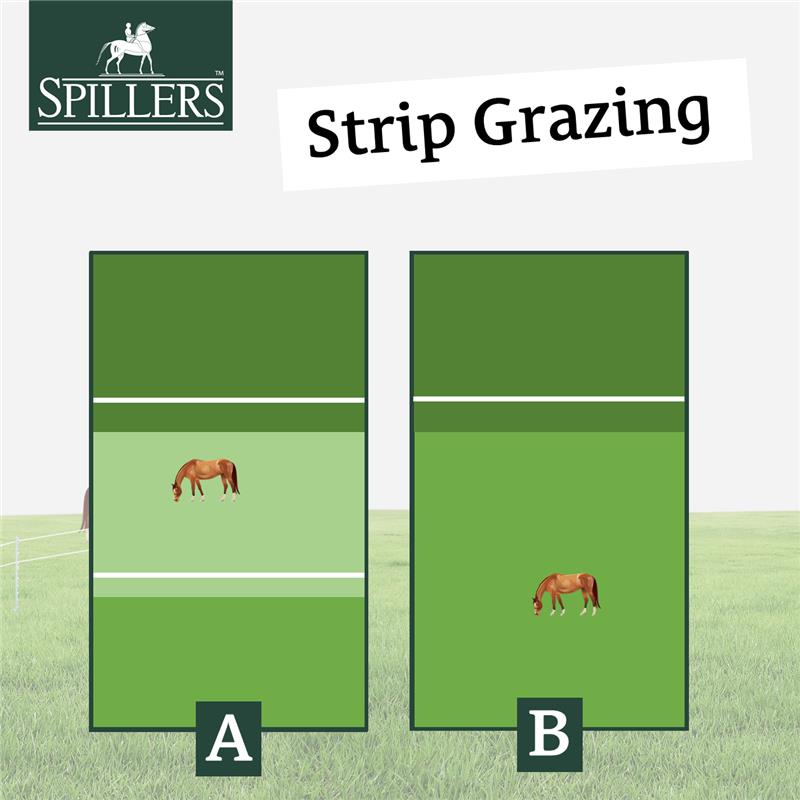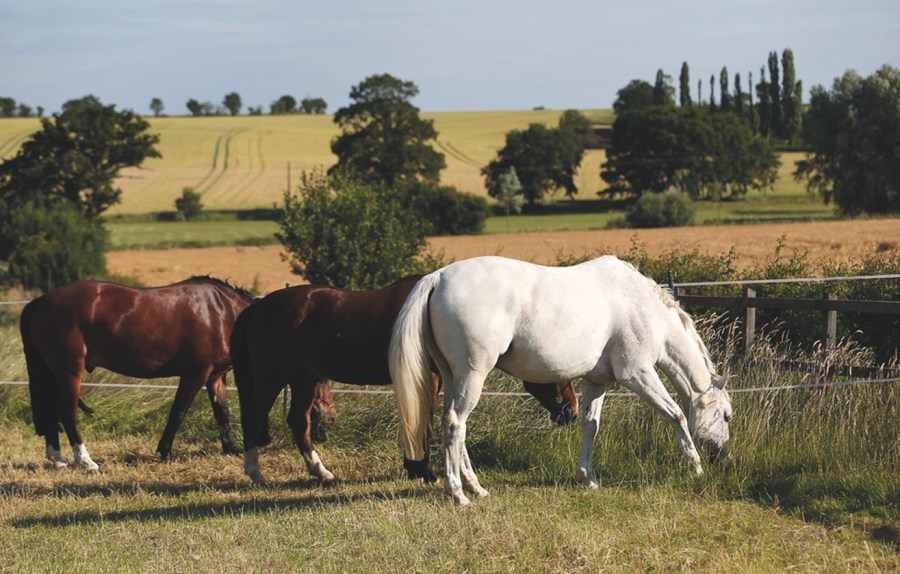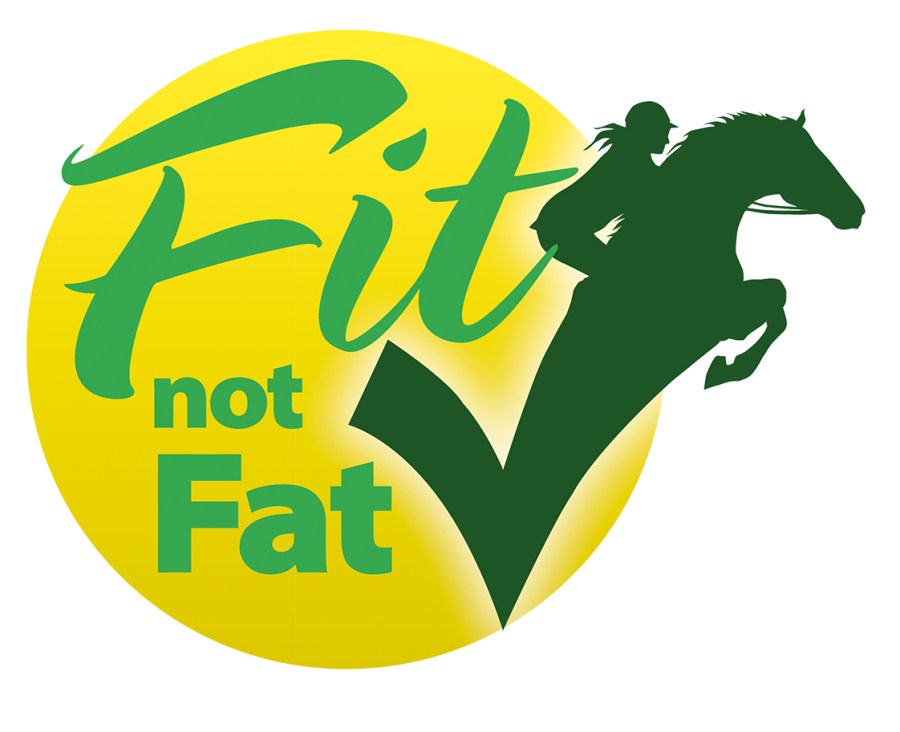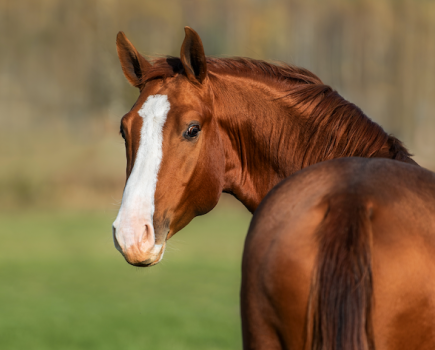In partnership with SPILLERS™
Whether your goal is to help a horse lose weight or maintain a healthy waistline, strip grazing is an effective way of achieving it. By using your field in this way you are able to continue turning them out while controlling the amount of grass the horse or pony can eat.
Systems are relatively easy to install and research (more on this below) has shown that they can help to restrict weight gain. Doing this alongside a healthy diet and providing plenty of exercise makes for an efficient equine weight management programme.
Strip grazing explained
Strip grazing is a method of sectioning off a smaller section of the horse’s field using electric fencing.
The fence is usually moved daily in order to provide gradual access to fresh grazing either with a back fence (see image A, below) or without a back fence (see image B).
If used, the back fence is moved by the same amount as the lead fence to keep the over-all grazing area the same size.
Without a back fence you have the advantage of only needing to use one electric fence. This way the grazed area will become larger each day, but in a recent study this was actually no less effective than when using a back fence as well.
The most appropriate distance for moving the fence will vary according to the following:
- Field size
- Quality and quantity of grass
- Rate of grass growth
- Number of horses in the paddock
- Body condition score (BCS) and weight control programme of the grazing horses

Why it’s necessary
Rates of obesity are considered to be as high as 70% in some populations of ponies, and with it comes an increased risk of serious health issues such as laminitis, joint strain, respiratory problems, equine metabolic syndrome, heat intolerance and reduced fertility.
At times of the year when grass is growing in abundance, the risk of weight gain and associated health problems is significantly increased.
This applies to all breeds and types of horses and ponies and is when strip grazing becomes particularly useful.
Kit required
You will need the following equipment in order to set up a field for strip grazing:
- Electric fencing tape — make sure it has a suitable break point in the event that a horse or pony should get tangled in it.
- Electric fencing posts — choose the right height of post for your horse; some may think nothing of jumping the height of short posts.
- Electric fence energiser — these are available as solar powered, battery powered or dual powered.
- Electric fence tester — to check that a suitable voltage is running through the tape.
- Spare posts, tape and batteries — just in case.
Strip grazing in practice
In practice, how far you should move the fence — and possibly whether a back fence may be beneficial — will depend on many factors.
These include:
- The size of the field and how many horses are turned out in it
- The weight/body condition score of the horse(s)
- The quality and quantity of grass available
- The rate of grass growth
Done correctly, strip grazing can help your horse or pony achieve and maintain a healthy weight, which is essential for their ongoing health and happiness.
Look out for cheats!
Some crafty horses or ponies may cheat and lean over the fence or poke their head under it in order to eat more than their daily allowance.
If this happens you may need to add a lower strand of electric tape or a top strand, or use taller electric fence posts to raise the overall height of the fence.
Always make sure the fence is electrified.
Some horses are particularly artful when it comes to noticing that the energiser isn’t working or that the electric charge running through the tape is weak.
They will soon learn that it’s fine to ignore it — which is not what you want.
Maintenance
As with any type of turnout, daily poo-picking is an essential part of your grazing management and worm control plan.
If you are back fencing too, remember that you always need to provide access to water. This may result in needing to invest in a longer hosepipe and a new water trough, or alternative buckets.
Monitor your horse’s weight and check their body condition regularly.
It may take several weeks for their body condition score to change, but weekly weigh taping will help you keep track of any changes in weight.
Strip-grazed fields need time to recover after they have been used and additional attention to pasture management, including weed control, may be needed.
Research
Research conducted by Dr Annette Longland of Equine Livestock and Nutrition Services in Wales, in collaboration with SPILLERS™, found that strip-grazed ponies gained significantly less weight than ponies with free access to restricted grazing over a 28 period, regardless of whether or not a back fence was used.
Twelve ponies were turned out in individual paddocks for 28 days.
All paddocks were 10m wide, but the length of the paddock was adjusted to be able to provide (at the start of the study) 1.5% of the ponies’ bodyweight (dry matter) in grass for 28 days.
To test the effect of strip grazing on weight gain, each pony was assigned to one of the following management practices or ‘treatments’ (4 ponies of similar height, weight and body condition per treatment):
- Total allowance
After a two-day adaptation period ponies were given access to their whole paddock - Strip grazing without a back fence
After a two-day adaptation period, the ‘lead fence’ was moved 1/26th of the remaining length of the paddock per day to provide controlled access to fresh grass - Strip grazing with a back fence
After a two-day adaptation period the lead fence and a ‘back fence’ was moved by 1/26th of the remaining length per day to allow fresh access to grass without increasing size of grazing area
Avoid overgrazing to reduce the risk of soil ingestion and pasture damage.
Have you heard about Your Horse’s #FitNotFat campaign? Equine obesity is an enormous welfare problem and we’re on a mission to provide owners and riders with the knowledge, skills and information you need in order to keep your horse in tip-top health. It could be life saving! Read the latest
Main image © Spillers







